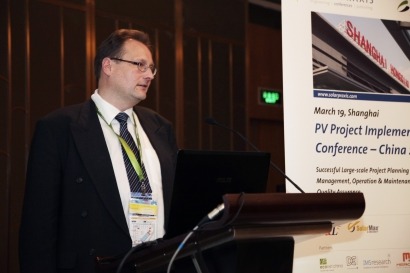
The one-day event organised by Solarpraxis dealt with project development, financing, construction, operating and monitoring of large-scale PV installations in China. After 2.89 gigawatts (GW) of photovoltaic capacity having gone online in China in 2011, one can expect another four to five GW to be installed this year.
In his keynote speech, Peter Xie from GCL Energy discussed China’s solar irradiation. He believes that Tibet and Western China offer the most development potential, particularly for large-scale solar installations. According to Xie, plummeting costs across the solar industry give China yet another advantage, with system costs falling "dramatically" from $2.37 per watt in the third quarter of 2011 to between $1.74 and $1.90 per watt in the first quarter of 2012.
Sebastian Trimpl from IBC Solar explained that China differed "significantly" from other solar markets thanks to its focus on large-scale projects. He said that these have an average capacity of 10 megawatts (MW), which is set to increase to 50 MW in the future. Trimpl believes China’s solar industry holds more potential than that of other countries in the world. To unlock this potential, he said, it is particularly important to overcome any problems in relation to political conditions and grid feed-in. It is not simply a case of generating as much energy as possible; we must also consider how to use any energy that cannot be fed into grid at the time. Timpl believes that other challenges need to be tackled in project financing and installer training to overcome system constructing problems. He even discussed dust and effective module cleaning. Timpl also said that attention must equally be given to quality standards that are not always on par with international standards.
Sebastian Meyer from Azure International pointed out that the domestic solar market would need to be better managed if it grew to a substantial size. Meyer said that it is expected that module companies will need to establish regional assembly operations, since many local subsidy programs favor locally-produced components. He also compared the development of China's solar industry with that of the wind industry and forecast that around 350 GW of wind power and 45 GW of photovoltaic power will be fed into the grid in the future. According to Meyer, solar energy is quicker to generate and requires less material than wind energy.
For additional information:

